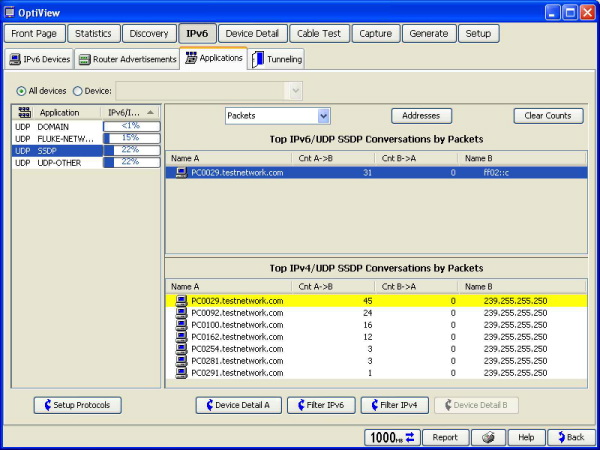
News
Integrated analyzers for one-stop troubleshooting by David Green Feb09
February 27, 2009 | By Anthony Capkun
Integrated analyzers for one-stop troubleshooting
By David Green, P.Eng.
With the explosion in converged and wireless applications, IT departments are facing an unprecedented number of new implementation and troubleshooting issues. Wireless networks, Voice over IP (VoIP) and new enterprise applications such as CRM (customer relationship management) are challenging IT departments to add capabilities to existing networks without compromising availability or performance.
In
a world where networks have become more mobile and dynamic, and
security requirements have changed significantly, end-to-end
management—from planning to ongoing maintenance—must constantly adapt
to change.
The changing landscape of the network professional
While
wireless, VoIP and other new applications might appear to require
different tools for verifying, testing and troubleshooting, there are
now integrated analyzers available that combine the functionality of
multiple test tools in one device, including:
 • Discovery
• Discovery
• Mapping/documentation
• SNMP polling
• Wire speed, hardware packet capture
• Protocol analyzer
• Traffic monitoring
• Host management utilities (telnet/ssh)
To gain
a clearer picture of how an integrated analyzer can support new
technology requirements, following are three examples that illustrate
how the different features can be utilized in the deployment of new
applications on existing networks.
Scenario 1: Deploying and maintaining a wireless network
Because
wireless networks still require a cabling, it’s important to have an
analyzer that can isolate problems on both the wired and wireless side
of the network. With a portable analyzer, an engineer can drill down
into the devices to see configuration details in order to troubleshoot
WLAN connectivity, authentication and performance issues.
For Wi-Fi applications, a portable analyzer can be used throughout the lifecycle of the deployment:
• During
the planning phase, a portable analyzer will ensure that the wired
network has enough drops and IP addresses available to support the new
access points and wireless users.
• The device can then be used to investigate what sort of throughput is expected and if 802.11b is sufficient.
• A site
survey and spectrum analysis can also be performed to explore factors
that affect wireless signal quality, such as RF (radio frequency)
interference.
• After
installation, the portable analyzer can be used to verify that the
initial design criteria were met, and to create baseline documentation.
• If in
the future users complain of a slow network, engineers can use the
device to investigate intermittent connectivity, login and
authentication problems; as well as to detect, identify and locate
unauthorized rogue devices and unprotected access points.
{mospagebreak}
Scenario 2: Deploying and maintaining VoIP across the enterprise
An
enterprise network manager planning to deploy VoIP must ensure the new
technology will meet users’ expectations for quality and performance.
Before any deployment, it is imperative to verify if the existing
infrastructure can support VoIP. The network team must also investigate
possible factors that can impair the quality of a VoIP call, including
jitter, delay and packet loss.
All
system elements should be thoroughly examined prior to deployment to
ensure the infrastructure devices are not introducing unacceptable
latency or dropping packets, and that they have sufficient bandwidth to
handle the increased traffic from the VoIP calls.
A
portable analyzer that is capable of both monitoring infrastructure
device performance and traffic additions to the network allows
engineers to easily verify that the network is capable of supporting
VoIP deployment with the existing infrastructure and traffic levels.
After
deployment, the same portable analyzer can be used to perform ongoing
monitoring and troubleshooting. It can capture VoIP traffic, analyze
call quality, and generate performance reports on delay, jitter and
packet loss.
Scenario 3: Deploying a new CRM application
Before
deploying a CRM application, it is essential to understand the
application’s traffic patterns and usage. A portable analyzer in a lab
setting is an ideal way to capture and analyze the necessary data.
The
engineer can then use the analyzer’s network discovery tool to assess
the organization’s existing network, in order to gain an understanding
of the environment and its ability to support the new CRM application.
The traffic monitoring feature will analyze the traffic patterns that
currently exist on the LAN/WAN and help engineers develop a migration
plan to install the new CRM software.
During
the installation phase, the network discovery feature is again used to
ensure that the new application has been correctly rolled out to all
locations. During the verification phase, an SNMP test and a traffic
analysis test will also verify that the bandwidth usage and latency of
the application do not exceed the design parameters.
As IT
managers continue to keep pace with technology changes and rising end
user expectations, the ultimate goal is to keep networks current
without losing consistency of performance. Whether deploying Wi-Fi,
VoIP or a new enterprise application, successful deployment is rooted
in proactively testing, verifying and troubleshooting throughout the
entire technology lifecycle.
David
Green, P.Eng., is director of marketing for Fluke’s AmPac Region,
including Canada, Australia and Latin America, and has been involved in
technical support, sales and marketing of various technologies for
communications, automation, testing and troubleshooting of industrial
and commercial systems for over 30 years. David is also the education
program manager for Fluke, working with educational institutions
globally to develop industry-education partnerships. E-mail
david.green@fluke.com to contact the author. CLICK HERE for Fluke Networks Canada.
Print this page